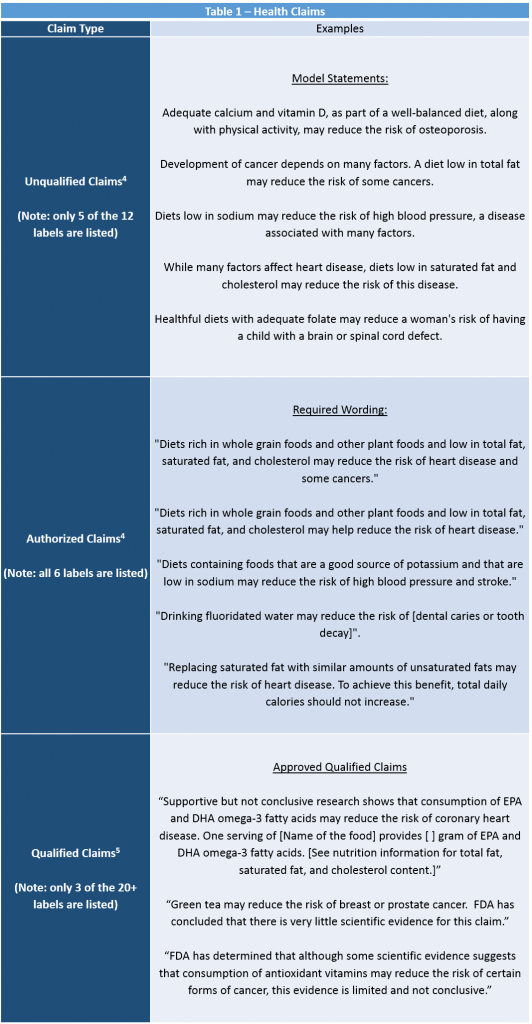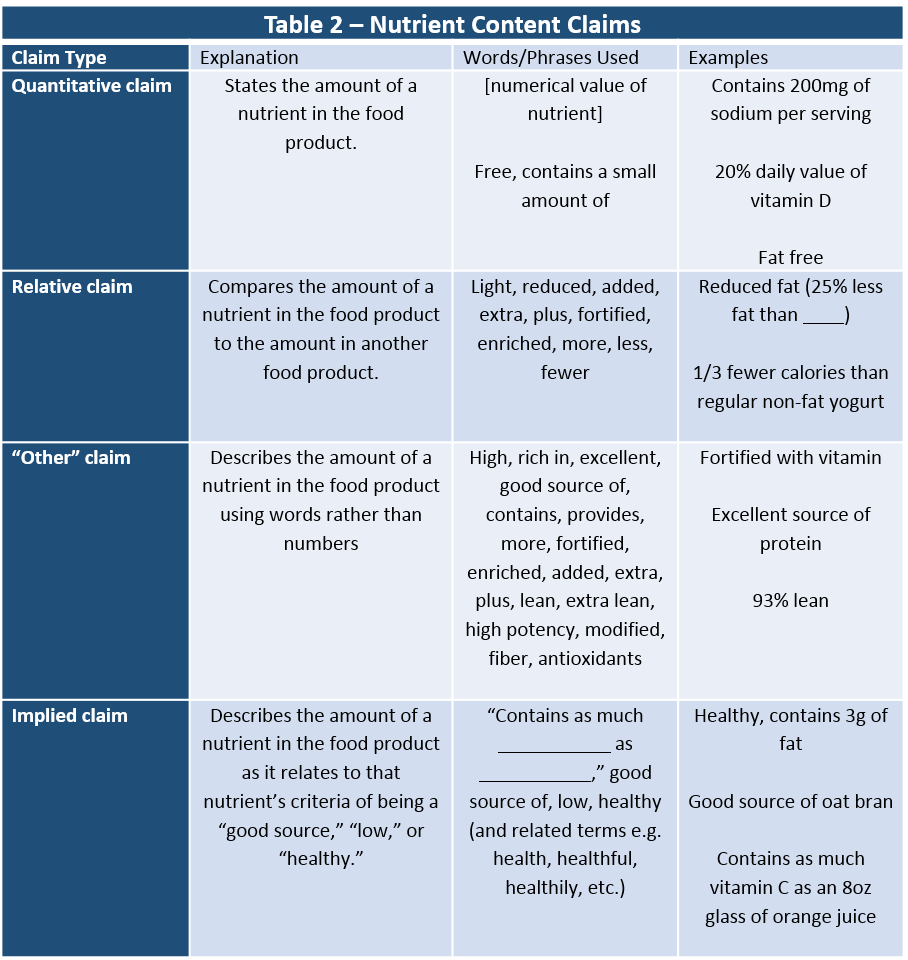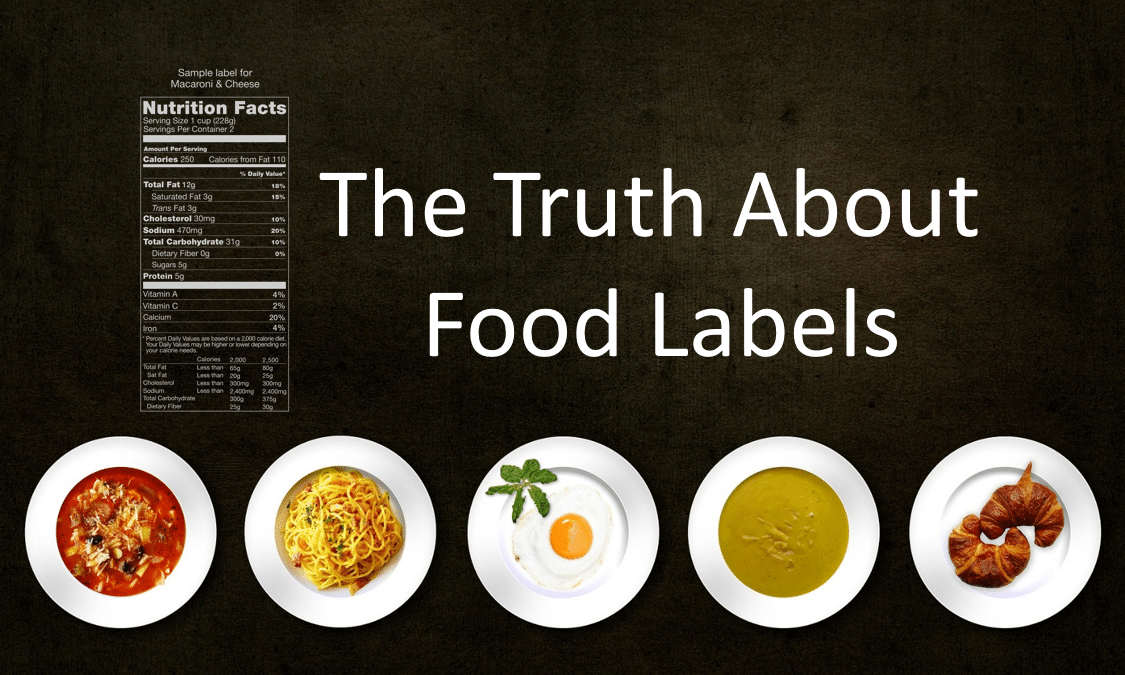By: Savannah Glasgow
tl;dr The phrases used on food labels can mean a variety of things depending on the context. For the most informative and accurate information, focus on quantitative values (e.g. “200mg of sodium per serving” or the Nutrition Facts label).
The Truth About Food Labels
Step into a grocery store and you’ll find aisle after aisle of packaged food that all sport various labels shouting nonsense at you like an excited classroom of kindergartners.
The food labels we see today are a product of the Food and Drug Administration’s Nutrition Labeling and Education Act (NLEA) of 1990. In an effort to better inform consumers about the contents of their food, the NLEA established specific guidelines to regulate what details a consumer could find (or not find) on their packaged foods. The act attempted to standardize the landscape of packaged food labels.
The NLEA requires each label to include the serving size, number of servings per container, the nutrient composition of food, and the ingredients list, among other details. Additionally, the act also established the “circumstances under which nutrition and health claims may and may not be made for foods.”1 A large majority of the label phrases found on food packaging fall into one of several categories of claims regulated by the NLEA. These categories are:
- Health Claims
- Nutrient Content Claims
- Structure-Function Claims
This article will explain what each of the claims is and provide examples of what the claim might look like as a food label.
Health Claims

The first type of claim is a health claim. “Health claims describe a relationship between a food substance… and reduced risk of a disease or health-related condition.”2 The claims are limited to disease risk reduction, not the “diagnosis, cure, mitigation, or treatment of disease.”3 In other words, these are the phrases on food packaging that describe how certain nutrients like sodium, fiber, and fat may influence the chances of developing diseases like hypertension, cancer, and heart disease from a dietary standpoint. This type of labeling is based on scientific evidence and is split into two categories: unqualified & authorized claims and qualified claims.
Unqualified & Authorized Claims
Unqualified & authorized claims are supported by the general consensus of the scientific community; “the totality of publicly available scientific evidence”3 must substantiate the claims. As such, there are only 18 nutrient-disease relationships with claims in this category— a dozen of these are unqualified with suggested phrasing provided for the label, and six are authorized with specific phrasing provided. As long as part of the food product includes “sufficient” amounts of the referenced nutrient, the food manufacturer can include the claim on their packaging at their discretion.
Qualified Claims
Qualified health claims are based on emerging evidence in nutrition research. Consequently, the label claim must include what the nutrient-disease relationship is currently thought to be and under what specific conditions this relationship is thought to be true. These claims must be paired with an appropriate qualifying disclaimer “to ensure that they are not false or misleading to consumers.”3
Nutrient Content Claims
The second type of claim is a nutrient content claim, and as the name implies, these are the labels that describe the content of a nutrient in the packaged food. The majority of regulated nutrient content claims “apply only to those nutrients that have an established Daily Value.”2 These claims are roughly broken down into four categories: quantitative, relative, other, and implied.

The label “healthy” (and all related terms such as health, healthful, healthiest, healthiness, etc.) is considered an Implied Claim. For a food product to be labeled as “healthy”, it must meet a set of criteria depending on which nutrients the manufacturer is referencing. Total fat, saturated fat, sodium, cholesterol, beneficial nutrients, and fortification each have their own set of criteria. This information can be found in the table “Conditions for Use of ‘Healthy’” found at the bottom of the webpage here.
And if you’re not confused enough at this point, there are some label phrases that appear to be implied claims; however, they don’t fall under the regulations that implied claims must follow. There are several different kinds of these common labels; some of these include:
- Statements that help consumers avoid certain substances for religious beliefs, intolerances and allergies, and lifestyle choices such as vegetarianism (example: “100% milk free” or “contains no honey”)
- Statements about substances that don’t add nutritional value (example: “No artificial color”)
- Statements that appear to add value to a product (example: “Made with real butter”)
- Statements that identify what the product is (example: “oat bran muffins” or “corn oil”)
Structure-Function Claims
The third type of claim is a structure-function claim. These are the phrases that “may describe the role of a nutrient or dietary ingredient intended to affect the normal structure or function of the human body… [or]… they may characterize the means by which a nutrient or dietary ingredient acts to maintain such structure or function.”2 Simply put, these claims describe how the nutrients you eat might influence your body and well-being. These labels are very similar to health claims; the driving difference is a lack of referenced disease or condition in the structure/function claim.
Here are a few examples:

Dietary Guidance
The previous three claims cover quite a large range of the labels found on packaged foods, but it’s by no means an exhaustive list. A similar label that food manufacturers include on their packaging is “dietary guidance.” These are phrases that generally contain one of the two components of a health claim i.e. dietary guidance either references a specific nutrient or it references a specific disease or condition.
Labels providing dietary guidance do not require approval from the FDA before inclusion on food packaging; however, the FDA can review the guidance after a product hits the market if the information seems questionable.
Some examples of dietary guidance include:
“Diets rich in fruits and vegetables may reduce the risk of some types of cancer.” – Here, the label is referring to the general grouping of fruits and vegetables rather than a specific nutrient.
“Calcium is good for your health.” – Here, the label uses a specific nutrient, but it associates it with a general state of well-being rather than a specific disease or condition.
“Natural”
At this point in time, the label “natural” is an unregulated term. The FDA currently considers “natural” to mean that “nothing artificial or synthetic (including all color additives regardless of course) has been included in, or has been added to, a food”6. Put another way, it is currently defined by what it is not, rather than by what it is.
That said, this lack of definition and regulation may be changing in the few years.
The FDA recently called for public opinion and comments on the use of “natural” as a food label in direct response to a growing usage of the term and a greater public awareness of the importance of good nutrition. The request for input was made in November 2015, and the commenting period ended in May 2016. In the six-month period, over 7,500 comments were received.
You can view the submitted comments by searching “FDA-2014-N-1207” at [https://www.regulations.gov/#!home].
As the food manufacturing landscape changes, the progression of this possible reform will be interesting to follow.
Conclusion
At the end of all this, hopefully you feel a little more informed about the kind of details food labels can provide. I know I certainly better understand how to evaluate information during my next trip to the grocery store. Yet “better” is very relative. This look into labeling also revealed how incredibly complex the regulations are, and these convoluted sets of criteria opened up a entirely new set of unanswered questions:
Are consumers actually paying attention to these labels and using them to make more informed decisions when they purchase food?
I know I spend time reading most of the statements and panels on my foods, but I’m a self-proclaimed nerd and thoroughly interested in the topic. I’m highly doubtful that this behavior is the norm.
Do consumers understand the set of criteria for each nutrient and for each type of claim? (And is that even important for them to know?)
While some information on a label may not be “misleading” to the FDA, who fully understand their criteria when something is considered “high in” a nutrient, that doesn’t necessarily mean the everyday consumer is not being mislead by some of the claims.
Do the label phrases provide information that’s applicable to everyone?
An individual with hypertension may have significantly different dietary needs in terms of their sodium intake than a healthy individual. Is a standardized “low sodium” label going to be low enough for them? Each population, whether it’s competitive athletes, mothers of newborns, elderly retirees, or middle-aged sedentary executives, will have its own nutritional needs, and blanket statements like “low xyz” or “good source of xyz” may not be relevant to each populations diet.
What information should a consumer pay attention to (if any) and what should they ignore (if any)?
Now, again, the answer to this question is going to vary from individual to individual depending on their nutritional goals. That said, my recommendation would be to gloss over the worded labels and instead focus on the quantitative labels. The labels that state an objective value for a nutrient, the labels that identify the presence or absence of a nutrient, and the Nutrition Facts panel are all going to give some concrete information that’s not relative to another product nor subjective to an individual’s diet. If you’re going to concern yourself with including a specific amount of a nutrient in your diet, your time is likely better spent identifying what that specific amount is, then checking how much of that nutrient is in your food, rather than spending time trying to decipher whether “excellent source of xyz” is going to meet your specific needs.
Readers what you think! Do you read any labels on the food packages you buy? Do they help you choose which products to purchase? Was any of this eye opening for you? Let us know in the comments, and let’s start a discussion on what labels you choose to pay attention to and find helpful. [In the next Labeling post, we’ll dive into what is important to know about the ingredients list, and explore the Nutrition Facts Panel, including the recent modifications to included added sugar amounts!]
References
(1) https://www.congress.gov/bill/101st-congress/house-bill/3562
(2) http://www.fda.gov/Food/IngredientsPackagingLabeling/LabelingNutrition/ucm111447.htm
(3) http://www.fda.gov/Food/IngredientsPackagingLabeling/LabelingNutrition/ucm207974.htm
(5) http://www.fda.gov/Food/IngredientsPackagingLabeling/LabelingNutrition/ucm073992.htm#birth

